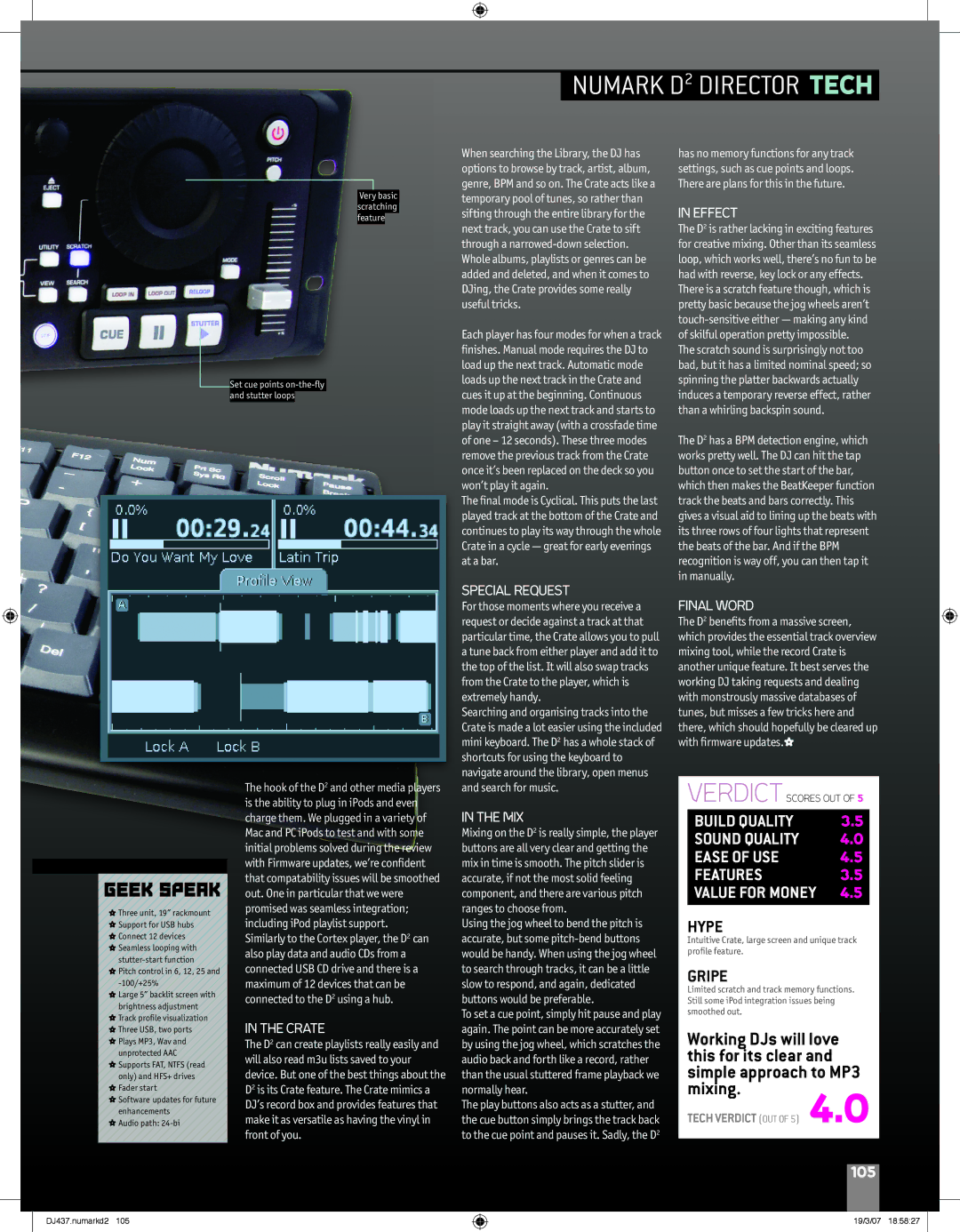
NUMARK D2 DIRECTOR TECH
Very basic scratching feature
Set cue points
When searching the Library, the DJ has options to browse by track, artist, album, genre, BPM and so on. The Crate acts like a temporary pool of tunes, so rather than sifting through the entire library for the next track, you can use the Crate to sift through a
Each player has four modes for when a track finishes. Manual mode requires the DJ to load up the next track. Automatic mode loads up the next track in the Crate and cues it up at the beginning. Continuous mode loads up the next track and starts to play it straight away (with a crossfade time of one – 12 seconds). These three modes remove the previous track from the Crate once it’s been replaced on the deck so you won’t play it again.
The final mode is Cyclical. This puts the last played track at the bottom of the Crate and continues to play its way through the whole Crate in a cycle — great for early evenings at a bar.
SPECIAL REQUEST
For those moments where you receive a request or decide against a track at that particular time, the Crate allows you to pull a tune back from either player and add it to the top of the list. It will also swap tracks from the Crate to the player, which is extremely handy.
has no memory functions for any track settings, such as cue points and loops. There are plans for this in the future.
IN EFFECT
The D2 is rather lacking in exciting features for creative mixing. Other than its seamless loop, which works well, there’s no fun to be had with reverse, key lock or any effects.
There is a scratch feature though, which is pretty basic because the jog wheels aren’t
The scratch sound is surprisingly not too bad, but it has a limited nominal speed; so spinning the platter backwards actually induces a temporary reverse effect, rather than a whirling backspin sound.
The D2 has a BPM detection engine, which works pretty well. The DJ can hit the tap button once to set the start of the bar, which then makes the BeatKeeper function track the beats and bars correctly. This gives a visual aid to lining up the beats with its three rows of four lights that represent the beats of the bar. And if the BPM recognition is way off, you can then tap it in manually.
FINAL WORD
The D2 benefits from a massive screen, which provides the essential track overview mixing tool, while the record Crate is another unique feature. It best serves the working DJ taking requests and dealing with monstrously massive databases of
*Three unit, 19” rackmount
*Support for USB hubs
*Connect 12 devices
*Seamless looping with
*Pitch control in 6, 12, 25 and
*Large 5” backlit screen with brightness adjustment
*Track profile visualization
*Three USB, two ports
*Plays MP3, Wav and unprotected AAC
*Supports FAT, NTFS (read only) and HFS+ drives
*Fader start
*Software updates for future enhancements
* Audio path:
The hook of the D2 and other media players is the ability to plug in iPods and even charge them. We plugged in a variety of Mac and PC iPods to test and with some initial problems solved during the review with Firmware updates, we’re confident that compatability issues will be smoothed out. One in particular that we were promised was seamless integration; including iPod playlist support.
Similarly to the Cortex player, the D2 can also play data and audio CDs from a connected USB CD drive and there is a maximum of 12 devices that can be connected to the D2 using a hub.
IN THE CRATE
The D2 can create playlists really easily and will also read m3u lists saved to your device. But one of the best things about the D2 is its Crate feature. The Crate mimics a DJ’s record box and provides features that make it as versatile as having the vinyl in front of you.
Searching and organising tracks into the Crate is made a lot easier using the included mini keyboard. The D2 has a whole stack of shortcuts for using the keyboard to navigate around the library, open menus and search for music.
IN THE MIX
Mixing on the D2 is really simple, the player buttons are all very clear and getting the mix in time is smooth. The pitch slider is accurate, if not the most solid feeling component, and there are various pitch ranges to choose from.
Using the jog wheel to bend the pitch is accurate, but some
To set a cue point, simply hit pause and play again. The point can be more accurately set by using the jog wheel, which scratches the audio back and forth like a record, rather than the usual stuttered frame playback we normally hear.
The play buttons also acts as a stutter, and the cue button simply brings the track back to the cue point and pauses it. Sadly, the D2
tunes, but misses a few tricks here and there, which should hopefully be cleared up with firmware updates.*
VERDICT SCORES OUT OF 5
BUILD QUALITY | 3.5 |
SOUND QUALITY | 4.0 |
EASE OF USE | 4.5 |
FEATURES | 3.5 |
VALUE FOR MONEY | 4.5 |
HYPE
Intuitive Crate, large screen and unique track profile feature.
GRIPE
Limited scratch and track memory functions. Still some iPod integration issues being smoothed out.
Working DJs will love this for its clear and simple approach to MP3 mixing.
TECH VERDICT (OUT OF 5) 4.0
www.djmag.com |
|
105 | |
|
|
DJ437.numarkd2 105
19/3/07 18:58:27
